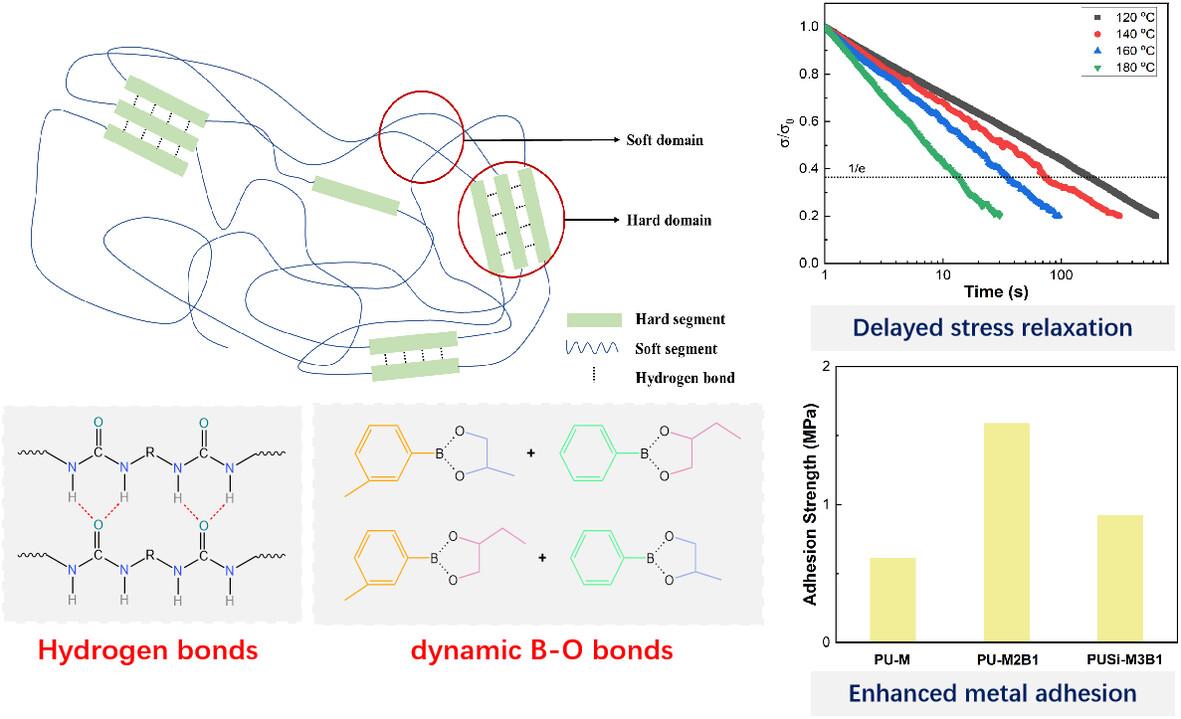Shilong Zhang, Youhao Xiong, Yangwei Wang, Yuqi Ma, Jialiang Li, Chaobo Jiang, Ce Wang, Yanling Zhu, Yongsheng Zhao, Guangcheng Zhang
求助PDF
{"title":"Silicone-containing polyurea elastomer possessing main-chain boron–oxygen bonds with delayed stress relaxation and improved adhesive properties","authors":"Shilong Zhang, Youhao Xiong, Yangwei Wang, Yuqi Ma, Jialiang Li, Chaobo Jiang, Ce Wang, Yanling Zhu, Yongsheng Zhao, Guangcheng Zhang","doi":"10.1002/pi.6671","DOIUrl":null,"url":null,"abstract":"<p>Polyurea (PU) elastomers have attracted considerable attention in the field of protective polymeric coatings. In this work, a dithiol-terminated boronic ester was synthesized and used to incorporate dynamic boron–oxygen (B–O) bonds in the PU main chain based on thiol isocyanate while amino-terminated polydimethylsiloxane (PDMS) was introduced to retain good chain flexibility. The modified PU elastomer was found to have a microphase-separated structure in which the hard blocks served as physical crosslinks. The glass transition temperature (<i>T</i><sub>g</sub>) slightly increases when dynamic B–O bonds exist while further introduction of PDMS soft segment can lower <i>T</i><sub>g</sub> to −55.63 °C. The introduction of dynamic B–O bonds and diminished hydrogen bonding led to a decrease in mechanical strength and elongation at break. Interestingly, the simultaneous incorporation of PDMS and dynamic B–O bonds is favorable for strain rate dependence and suppressing stress relaxation. The potential for bond-exchange interactions between the dynamic B–O bonds and hydroxyl groups on metal surfaces substantially improved the adhesion of the PU elastomer to metal substrates. Therefore, our work can offer valuable insights for the structural design of functional PU coatings tailored for anti-impact applications. © 2024 Society of Chemical Industry.</p>","PeriodicalId":20404,"journal":{"name":"Polymer International","volume":"73 10","pages":"874-882"},"PeriodicalIF":3.6000,"publicationDate":"2024-06-21","publicationTypes":"Journal Article","fieldsOfStudy":null,"isOpenAccess":false,"openAccessPdf":"","citationCount":"0","resultStr":null,"platform":"Semanticscholar","paperid":null,"PeriodicalName":"Polymer International","FirstCategoryId":"92","ListUrlMain":"https://onlinelibrary.wiley.com/doi/10.1002/pi.6671","RegionNum":4,"RegionCategory":"化学","ArticlePicture":[],"TitleCN":null,"AbstractTextCN":null,"PMCID":null,"EPubDate":"","PubModel":"","JCR":"Q2","JCRName":"POLYMER SCIENCE","Score":null,"Total":0}
引用次数: 0
引用
批量引用
Abstract
Polyurea (PU) elastomers have attracted considerable attention in the field of protective polymeric coatings. In this work, a dithiol-terminated boronic ester was synthesized and used to incorporate dynamic boron–oxygen (B–O) bonds in the PU main chain based on thiol isocyanate while amino-terminated polydimethylsiloxane (PDMS) was introduced to retain good chain flexibility. The modified PU elastomer was found to have a microphase-separated structure in which the hard blocks served as physical crosslinks. The glass transition temperature (T g ) slightly increases when dynamic B–O bonds exist while further introduction of PDMS soft segment can lower T g to −55.63 °C. The introduction of dynamic B–O bonds and diminished hydrogen bonding led to a decrease in mechanical strength and elongation at break. Interestingly, the simultaneous incorporation of PDMS and dynamic B–O bonds is favorable for strain rate dependence and suppressing stress relaxation. The potential for bond-exchange interactions between the dynamic B–O bonds and hydroxyl groups on metal surfaces substantially improved the adhesion of the PU elastomer to metal substrates. Therefore, our work can offer valuable insights for the structural design of functional PU coatings tailored for anti-impact applications. © 2024 Society of Chemical Industry.
含硅聚脲弹性体具有主链硼氧键,可延迟应力松弛并改善粘合性能
聚脲(PU)弹性体在聚合物保护涂层领域备受关注。在这项研究中,我们合成了一种二硫醇封端的硼酸酯,并利用它在聚氨酯主链中加入了基于硫醇异氰酸酯的动态硼-氧(B-O)键,同时引入了氨基封端的聚二甲基硅氧烷(PDMS)以保持良好的链柔性。研究发现,改性聚氨酯弹性体具有微相分离结构,其中的硬块起到了物理交联的作用。当存在动态 B-O 键时,玻璃化转变温度(Tg)略有升高,而进一步引入 PDMS 软段可将 Tg 降至 -55.63 °C。动态 B-O 键的引入和氢键的减少导致了机械强度和断裂伸长率的下降。有趣的是,同时加入 PDMS 和动态 B-O 键有利于应变速率依赖性和抑制应力松弛。动态 B-O 键与金属表面羟基之间潜在的键交换相互作用大大提高了聚氨酯弹性体与金属基底的粘附性。因此,我们的工作可为抗冲击应用定制的功能性聚氨酯涂层的结构设计提供有价值的见解。© 2024 化学工业协会。
本文章由计算机程序翻译,如有差异,请以英文原文为准。


 求助内容:
求助内容: 应助结果提醒方式:
应助结果提醒方式:


